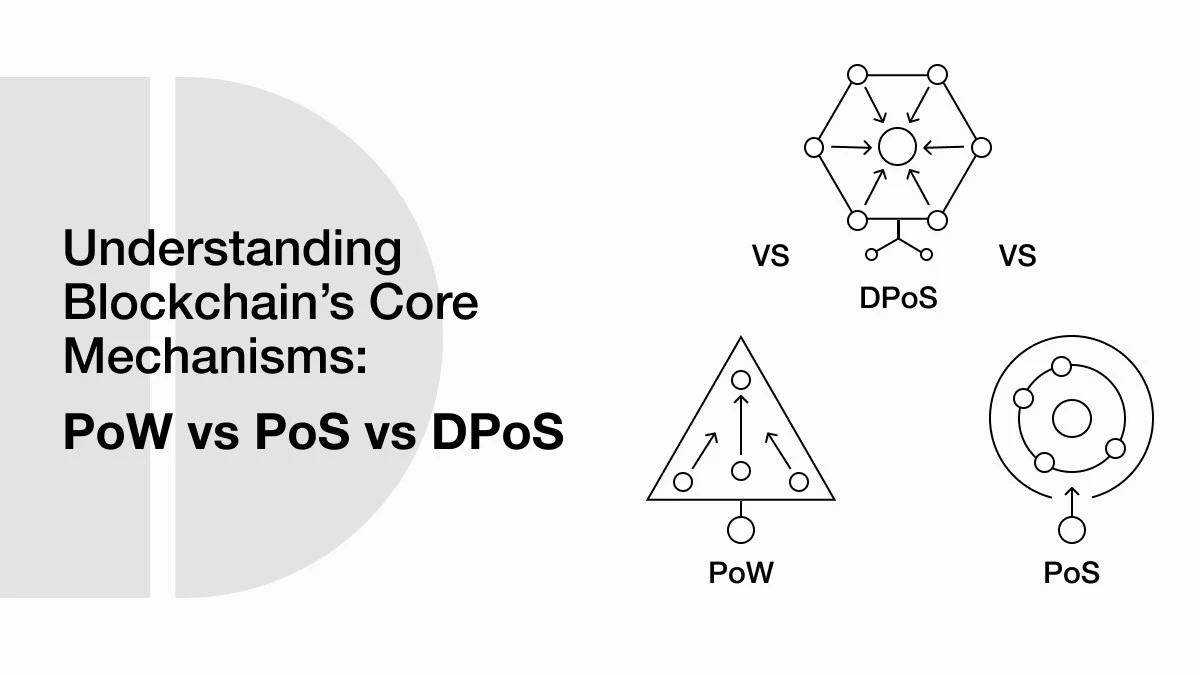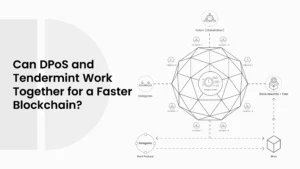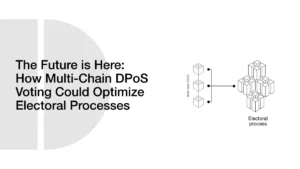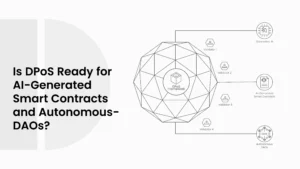DPoS vs PoS vs PoW: What’s the Difference and Why It Matters

Any blockchain essentially relies on consensus mechanisms for functioning. They ascertain how members in a network come to agree on the validity of transactions, the inclusion of blocks in the chain, and how their trust is maintained in a decentralized environment.
- What Does a Consensus Mechanism Do?
- Proof of Work: Security Through Computation
- Proof of Stake: Efficiency Through Ownership
- Delegated Proof of Stake: Speed and Governance Through Voting
- How PoW, PoS, and DPoS Compare in Practice
- How Consensus Choices Shape Blockchain Design and Utility
- Conclusion: A Defining Choice for Any Blockchain
- Frequently Asked Questions (FAQs)
- Glossary of Key Terms
In order for a blockchain to function securely or justly, it can never be without a consensus protocol. As technology advances, understanding how these various mechanisms function and how each varies remains crucial for developers, buyers, and investors.
A prime example among the most widely used models is Proof of Work (PoW), Proof of Stake (PoS), and Delegated Proof of Stake (DPoS). All three provide a unique method for establishing consensus, and all are good, bad, and best used for specific purposes.
What Does a Consensus Mechanism Do?
Blockchains are decentralized; there is no central authority confirming transactions. Instead, participants across the system must agree in accord on “what is real”, “what makes transactions valid”, and “what blocks to add to the chain”.
Consensus algorithms give the rules and the framework for this agreement. Protecting the network from cheating and maintaining synchronization among nodes while allowing the system to run efficiently even if some of the participants behave dishonestly, they are the set of rules.
How it achieves consensus affects a blockchain’s energy consumption, scalability, degree of decentralization, and attack resistance.
Proof of Work: Security Through Computation
Proof of Work (PoW) is the first such consensus algorithm proposed by Bitcoin in 2009. It answers the question of how to trustlessly and securely come to a consensus about the state of a decentralized network with no central entity. In an open participation peer-to-peer system, PoW enables a single valid block to be added to the blockchain at any given moment by requiring miners to solve a complex mathematical puzzle. Double spending is prevented, the accuracy of the ledger is guaranteed, and it is extremely hard for malicious agents to alter transaction history. The miner who successfully solves the puzzle is allowed to add the next block and is rewarded.
This system provides strong security. Solving these puzzles requires real-world energy and computation, making it extremely difficult to manipulate the network. With its decentralized nature, PoW is also resistant to attacks since anyone with hardware and electricity can participate.
ALSO READ: DPoS Explained: How Blockchain Users Elect Validators
However, PoW is inefficient. It consumes enormous amounts of electricity and advanced mining equipment. With growing networks, the transaction speeds are comparatively slower, and scalability becomes a concern. Bitcoin and Litecoin are two big blockchains that still rely on PoW.
Proof of Stake: Efficiency Through Ownership
PoW’s inefficiencies were addressed by creating Proof of Stake (PoS). Instead of miners, PoS uses validators. These participants are selected based on the number of tokens they own and are willing to lock up, or “stake,” as collateral.
PoS significantly reduces energy consumption since it does not involve intensive computation. Also, faster block confirmation being enabled and the barrier to entry lowered, anyone with tokens can become a validator. Validators have a financial stake in the network, and so they are incentivized to act honestly. Penalties or loss of staked assets could be the outcome of misbehavior.
But PoS also raises new issues. Large-stake token holders can dominate, centralizing control. Others also contend that PoS is susceptible to the “nothing at stake” problem, where validators might validate multiple chains simultaneously without penalty.
Despite these difficulties, PoS has been heavily adopted. Ethereum is the second-largest blockchain, which transitioned from PoW to PoS in 2022.
Delegated Proof of Stake: Speed and Governance Through Voting
Delegated Proof of Stake, or DPoS, is a development of PoS that incorporates a more structured form of governance. Instead of all token holders being validators, they vote to select a few trusted members who are known as delegates or block producers.
These are the delegates who authenticate transactions, build blocks, and help secure the network. Because a finite number of delegates are online at any given time, the building of blocks is very rapid and effective.
DPoS is very high-throughput and low-latency and is suitable for use cases where there is a requirement for real-time. The voting mechanism also adds a governance element; delegates can be replaced if they fail to deliver.
However, DPoS introduces centralization risks. Since power is concentrated among a small group of elected delegates, there’s a possibility of collusion or voter manipulation. This model depends heavily on active community participation to remain fair and accountable.
EOS, TRON, and BitShares all use DPoS. Komodo implements a hybrid model combining DPoS with additional security layers.
How PoW, PoS, and DPoS Compare in Practice
Striking a distinct balance between performance, security, decentralization, and sustainability, this is how each model compares.
- PoW is considered the most secure and decentralized, requires significant energy, and offers lower throughput. Research by universities like Cambridge University and researchers on arXiv.org reveals that PoW’s energy usage can come close to that of small nations.
- PoS offers much better energy efficiency and faster transaction times. It lowers operational costs and increases accessibility, but may shift power toward wealthier participants.
- DPoS takes performance even further. By limiting the number of validators and enabling fast block production, it delivers excellent scalability. But it sacrifices some decentralization, relying on elected delegates and active voter engagement to maintain trust.
Security models also differ. PoW’s computational difficulty defends against attacks but limits speed. PoS builds an economic-based security on the threat of financial sanctions. DPoS puts faith in the elected delegates, which makes social dynamics and transparency essential to its integrity.
How Consensus Choices Shape Blockchain Design and Utility
The consensus algorithm that a blockchain employs has extensive implications. How transactions are processed, the extent of the network being scalable, how much energy it consumes, and how easy it is for users to participate are all factors influenced by the consensus algorithm.
For example, a decentralized and censorship-resistant blockchain could opt for PoW, tolerating slower speeds and increased energy consumption. A high-volume transaction platform, such as gaming or real-time applications, would opt for DPoS in order to leverage its speed. A tradeoff solution like PoS would be suited for general-purpose networks that call for both efficiency and decentralization.
These decisions influence governance frameworks, upgrade processes, and sustainability. Developers, users, and investors need to appreciate the implications of every model in assessing blockchain ventures.
Consensus is not a background detail. It is a strategic decision that shapes the core identity and function of a blockchain network.
Conclusion: A Defining Choice for Any Blockchain
Proof of Work, Proof of Stake, and Delegated Proof of Stake each offer a unique approach to solving the problem of consensus in decentralized systems.
PoW emphasizes security through computational work but demands high energy input. PoS streamlines the process by incentivizing those who have an economic interest in the network. DPoS increases speed and adds democratic decision-making by enabling token holders to vote for accountable delegates.
The consensus mechanism being right is not merely about performance. Trust, sustainability, governance, and community values are all equally important. How these models differ offers crucial understanding that empowers all participants to make better decisions when it comes to either building platforms, evaluating investments, or participating in governance.
Frequently Asked Questions (FAQs)
- What are the main differences between PoW, PoS, and DPoS?
- PoW uses computational power to validate transactions.
- PoS selects validators based on token ownership.
- DPoS elects a small group of delegates through community voting to perform validation.
Each balances security, efficiency, and decentralization differently.
- Why is Proof of Work (PoW) considered highly secure but inefficient?
PoW secures the network by requiring miners to solve complex puzzles, making manipulation extremely difficult. However, it consumes a lot of energy and is relatively slow, making it less scalable. - How does Proof of Stake (PoS) improve on PoW?
PoS replaces energy-intensive mining with token-based validation, reducing environmental impact and increasing speed. However, it can concentrate power among wealthier token holders and may suffer from lower decentralization. - What makes Delegated Proof of Stake (DPoS) faster and more scalable?
DPoS limits block production to a small number of elected delegates, making block validation quicker. It introduces governance through voting but relies heavily on active community participation to prevent centralization and collusion. - How do I decide which consensus model is best for a blockchain project?
Choose PoW for maximum decentralization and censorship resistance, PoS for balanced performance and energy efficiency, and DPoS for high throughput and real-time applications where governance and speed matter most.
Glossary of Key Terms
Consensus Mechanism: A protocol used by blockchain networks to achieve agreement on the validity of transactions without a central authority.
Proof of Work (PoW): A consensus model where miners solve cryptographic puzzles to validate transactions. It’s secure but energy-intensive. Used by Bitcoin and Litecoin.
Proof of Stake (PoS): A more efficient alternative to PoW where validators are chosen based on the number of tokens they “stake” or lock up as collateral.
Delegated Proof of Stake (DPoS): A variation of PoS where token holders vote for a limited number of delegates who validate transactions. Known for speed and governance features.
Validator: A participant in a blockchain network who is authorized to verify transactions and create blocks. In PoS and DPoS systems, validators replace traditional miners.
Delegate (Block Producer): In DPoS, a trusted participant elected by the community to validate transactions and secure the network.
Nothing at Stake Problem: A theoretical risk in PoS systems where validators might support multiple competing chains without facing penalties, potentially causing forks or double-spending.
Decentralization: The distribution of control and decision-making away from a central authority. A key principle in blockchain, though each model balances it differently.
Throughput: The number of transactions a blockchain can process per second. Higher in DPoS, lower in PoW.
Staking: The process of locking up tokens in a PoS or DPoS system to become a validator or to vote for one, offering a financial stake in the network’s honesty.




